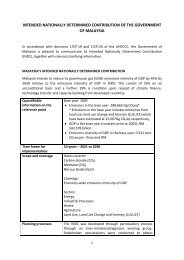RP-01638
RP-01638
RP-01638
Create successful ePaper yourself
Turn your PDF publications into a flip-book with our unique Google optimized e-Paper software.
original diameter) x 1001(original diameter).<br />
The angular position of the hole was defined<br />
as 0 = 0° for the diameter in the plane of the<br />
lever and 0 = 90° for the diameter perpendicular<br />
to it. Wear in the bore of the wooden<br />
bushing was plotted against calendar time<br />
and against total work output (Fig. 10). As<br />
expected, the wear was more dependent on<br />
the total work output than on calendar time.<br />
The magnitude of the wear also varied from<br />
handpump to handpump depending not only<br />
on the total work output but also on the<br />
dampness of the wooden bushing and the<br />
slack in the lever system. It was also not<br />
surprising that the wear in the plane of the<br />
lever (0 = 0°) was greater than that perpendicular<br />
to it (0 = 90°).<br />
Wear of the high<br />
Wear of piston rings<br />
density polyethylene piston rings was calculated<br />
as a percentage from: (original thickness<br />
- measured thickness) x 100/(original thickness).<br />
Wear of the piston rings was also<br />
plotted against calendar time and against total<br />
work output. Again, the wear is more a<br />
function of total work output than calendar<br />
time. The average total wear of the piston<br />
rings over the 8.5-month period was of the<br />
order of 4%.<br />
Wear of the<br />
cylinder<br />
pumping section of the handpump<br />
At the end of the field test, the<br />
PVC pump cylinder was replaced by a new<br />
cylinder. The original pump cylinder was cut<br />
into two halves along its cylindrical axis and<br />
the wall thickness measured in the laboratory.<br />
Figure 11 shows the variation of wall thickness<br />
of the pumping section of the PVC<br />
cylinder of a handpump that had been in use<br />
in the field for approximately 2 years. Wear<br />
was very significant and had extended, in this<br />
case, to about two-thirds of the original wall<br />
thickness of the handpump cylinder. In the<br />
present design, high density polyethylene<br />
piston rings were used and the above results<br />
show that the PVC cylinder wears more than<br />
the polyethylene piston rings. This shows<br />
that the original choice of materials is not<br />
satisfactory. Because it is easier and more<br />
economical to replace the piston rings than<br />
the pumping cylinder, it is more desirable to<br />
have a combination where the piston rings<br />
wear while the pumping cylinder is more<br />
resistent to wear.<br />
A member of the present project team, in a<br />
current experimental investigation, has shown<br />
that low density polyethylene wears about 10<br />
times faster than high density polyethylene<br />
when rubbing against PVC material in clear<br />
water. However, until further tests are<br />
carried out to determine whether piston rings<br />
made from low density polyethylene or some<br />
other material can reduce wear in the PVC<br />
cylinder significantly in a field environment, a<br />
temporary solution to the cylinder wear<br />
problem is to raise the piston to a new,<br />
unworn, section of the pumping cylinder<br />
after every 2 years of use.<br />
Conclusions<br />
After approximately 2 years of use in the<br />
field, except for severe wear of the PVC<br />
pumping cylinder, the handpump of the present<br />
design appears to have withstood the<br />
wear and tear of everyday use and required<br />
only minor maintenance and repair. Routine<br />
maintenance is required after every 2 years<br />
either to replace the worn section of the<br />
cylinder or to raise the piston to an unworn<br />
section of the cylinder.<br />
Because the major components of the<br />
present handpump are made from plastics,<br />
the use of injection moulding techniques<br />
offers great promise for cost reduction when<br />
the handpump is produced in large numbers.<br />
Acknowledgment This project was funded by a<br />
grant from the International Development Research<br />
Centre. This is gratefully acknowledged. The<br />
author would like to thank the local Ministry of<br />
Health personnel in Ipoh, Seremban, and Kuala<br />
Pilah for their cooperation in getting the handpumps<br />
installed and monitored during the field test.<br />
Last, but not least, our appreciation goes to the<br />
village users of our present handpumps for their<br />
patience and tolerance during the field tests.<br />
Re ferences<br />
Goh, S.Y. 1980. The performance characteristics of<br />
a reciprocating piston water lift pump. Ottawa,<br />
Ont., Canada: International Development Research<br />
Centre. Interim progress report, Water pumping<br />
technology - Global project.<br />
Sternberg, Y. 1978. Testing of wood bearings for<br />
handpumps. Washington, DC, USA: International<br />
Bank for Reconstruction and Development.<br />
Research Working Paper Series, P.U. Report No.<br />
RES 13.<br />
52



